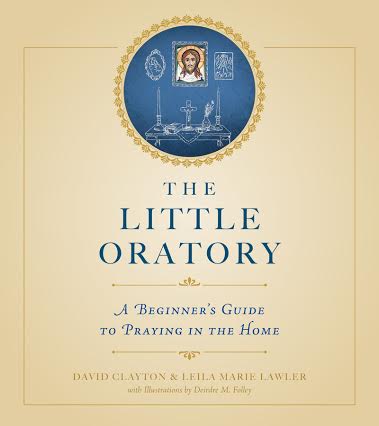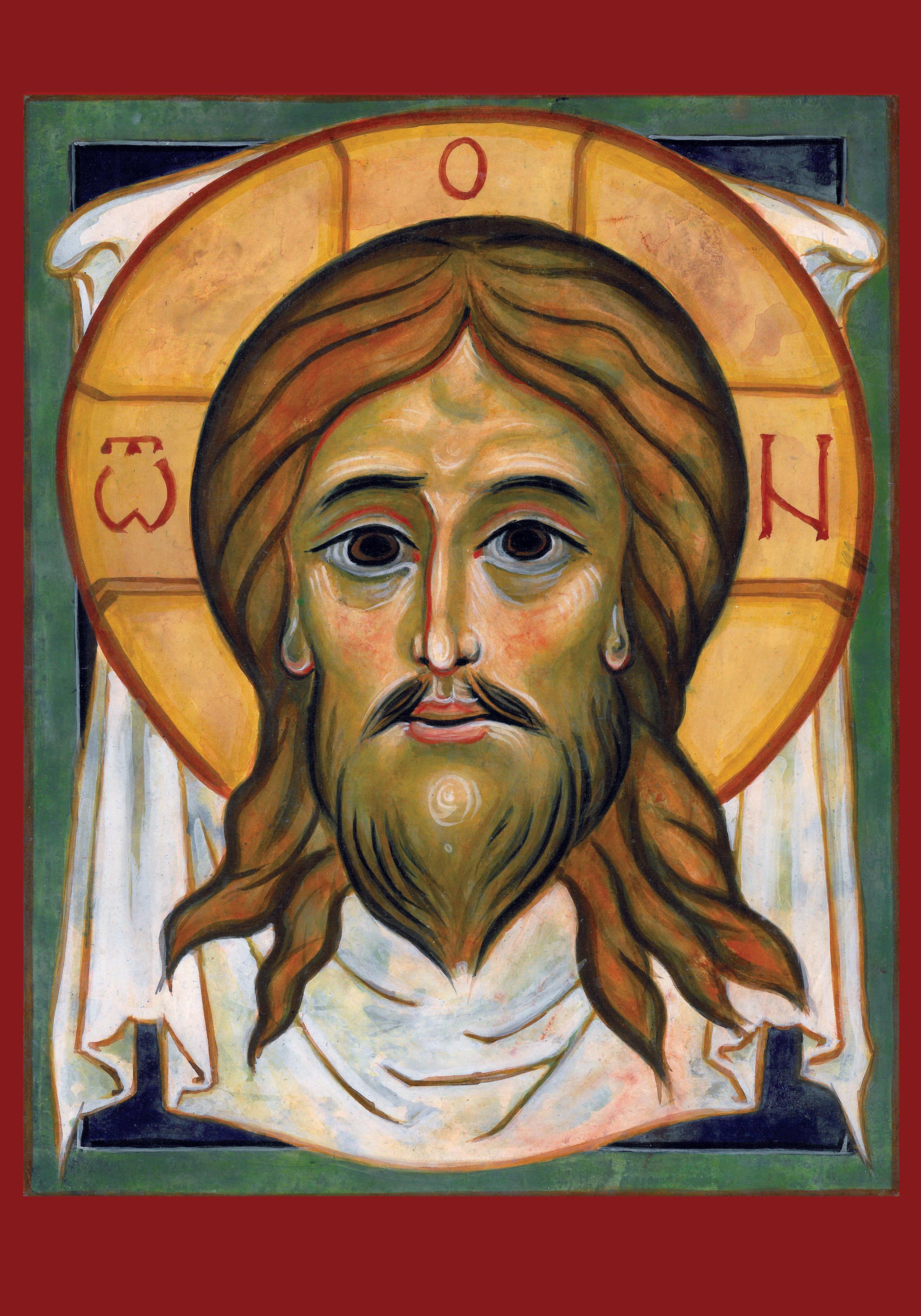If doctors don’t say what health is, how can we be certain that they are making us healthy?
Biblical Typology for Christmas in a Liturgical Hymn: Words, Music and Art
New book for prayer in the home that will 'transform the family and society'
 My book, co-authored with Leila Lawler, is now out and can be ordered from the publisher Sophia Institute Press. It is called The Little Oratory - A Beginner's Guide to Praying in the Home. The claim in the title about the impact it will have, incidentally, is not my own but is taken from a review by Scott Hahn, which I give in full below (although I do hope his assessment is correct!)
It is a practical program in mystagogy - the teaching of the mysteries of the Faith - that promotes a cultural renewal through a liturgical piety in the family and parish. It explains how to build a prayer corner - a 'little oratory' - as the centre of family prayer and has eight color detachable icons in standard sizes for framing, to get you started. The paintings you see in this article are from the book.
My book, co-authored with Leila Lawler, is now out and can be ordered from the publisher Sophia Institute Press. It is called The Little Oratory - A Beginner's Guide to Praying in the Home. The claim in the title about the impact it will have, incidentally, is not my own but is taken from a review by Scott Hahn, which I give in full below (although I do hope his assessment is correct!)
It is a practical program in mystagogy - the teaching of the mysteries of the Faith - that promotes a cultural renewal through a liturgical piety in the family and parish. It explains how to build a prayer corner - a 'little oratory' - as the centre of family prayer and has eight color detachable icons in standard sizes for framing, to get you started. The paintings you see in this article are from the book.
 It addresses the crisis of fatherhood by explaining crucial role of fathers in family prayer. By encouraging fathers (as well as mothers!) to be an example in prayer it will help to encourage vocations for it will teach boys that prayer and worship are masculine activities as well as feminine.
It addresses the crisis of fatherhood by explaining crucial role of fathers in family prayer. By encouraging fathers (as well as mothers!) to be an example in prayer it will help to encourage vocations for it will teach boys that prayer and worship are masculine activities as well as feminine.
As such it is a family centered, practical manual for the New Evangelisation that could be promoted by parishes or cultural centres. It explains how family prayer can be the basis for building up communities beyond the family in parishes, for example, and even the workplace.
Here is what Scott Hahn wrote about it:
'This is one of the most beautiful books I've ever seen. How I wish I'd had it when I first became a Catholic, not just for myself, as a husband and father, but for my family, too. It's a commonplace of Christian tradition to call the home a sanctuary or "domestic church," but before a home can be a church, it must become an oratory -- a place of prayer. The authors of this book know that there are many obstacles, and they show us how to overcome them. This book is inspiring yet practical, realistic yet revolutionary. If one book has the potential to transform the Catholic family (and society), this is it.'
![]() It adapts for the family the traditional spirituality of artists that forms the person in humility so that they are open to inspiration and it engenders creativity. In addition it describes the practical aspects of an education in beauty based upon the traditional education of artists and how this can be applied at any level. It could be introduced, for example, into homeschooling groups, at a college level (I have been doing this in my Way of Beauty class) or even the basis of an MFA. The Sophia Institute Press site here [] includes downloadable high resolution prints of the icons in the book and numerous line drawings for coloring and for copying to help teach children how to draw (scroll down to the bottom of the page and you'll find the link). This really is useful at all levels - I teach adults in my classes using these same images.
It adapts for the family the traditional spirituality of artists that forms the person in humility so that they are open to inspiration and it engenders creativity. In addition it describes the practical aspects of an education in beauty based upon the traditional education of artists and how this can be applied at any level. It could be introduced, for example, into homeschooling groups, at a college level (I have been doing this in my Way of Beauty class) or even the basis of an MFA. The Sophia Institute Press site here [] includes downloadable high resolution prints of the icons in the book and numerous line drawings for coloring and for copying to help teach children how to draw (scroll down to the bottom of the page and you'll find the link). This really is useful at all levels - I teach adults in my classes using these same images.
 In addition it explains:
• Why the Liturgy of the Hours is important and how it can make your family holy
• How to sing your prayers even if you think you're tone deaf or timid
• How to pray the Rosary with children—and keep the rowdiest of them calm and reverent
• The active role children can play in the prayer life of the family and how to raise the cultural sensibilities of your children so they are more sensitive to divine beauty.
• What to do when only one parent takes the spiritual life seriously
• How to overcome the feeling that you’re too busy to pray
• Practical ways to extend the liturgical life into your workplace
In addition it explains:
• Why the Liturgy of the Hours is important and how it can make your family holy
• How to sing your prayers even if you think you're tone deaf or timid
• How to pray the Rosary with children—and keep the rowdiest of them calm and reverent
• The active role children can play in the prayer life of the family and how to raise the cultural sensibilities of your children so they are more sensitive to divine beauty.
• What to do when only one parent takes the spiritual life seriously
• How to overcome the feeling that you’re too busy to pray
• Practical ways to extend the liturgical life into your workplace
It has been well received so far and is endorsed also, by figures such as Joseph Pearce, Christopher West and Tom Howard. It is with the words of well-known Catholic writer Tom Howard that I finish: 'It is difficult indeed to refrain from superlatives when speaking of this book. It's all here. One would like to shout from the housetops, "Drop everything and start using this!" Here we find virtually all that could possibly be wanted for true Catholic household prayer. The liturgy, the Church year, the Hours, music, chant, icons, the Rosary, lots of "how to" helps, even tips on Catholic household décor. And the great thing is that it is all presented in clear, strong, sane, modest, unembellished prose. The helpful commentaries turn out to be luminous meditations actually. The book is a rare treasure.'
Buy the Little Oratory - A Beginner's Guide to Prayer in the Home from the Sophia Institute Press site, here.
The Mystery of Mystagogy! Catholic Education is an Education in the Liturgy...nothing else!
 As described before, on my return from the Sacra Liturgia 2013 conference in Rome I wrote an article for Catholic Education Daily in which I argued that the essence of Catholic education is education in the liturgy. The article is A School of Love: the Sacred Liturgy and Education. As part of the recommended reading of the conference and since writing this I got around to reading Sacramentum Caritatis. Within the section on 'mystagogy' this very matter is discussed directly.
Mystogogy means literally in Greek, 'learning about the mysteries'. Mystagogy in this context is, to quote Stratford Caldecott ‘the stage of exploratory catechesis that comes after apologetics, after evangelization, and after the sacraments of initiation (baptism, Eucharist, and confirmation) have been received’ and is sometimes referred to a formal stage of education of the newly baptised Christian in living out the faith.
As described before, on my return from the Sacra Liturgia 2013 conference in Rome I wrote an article for Catholic Education Daily in which I argued that the essence of Catholic education is education in the liturgy. The article is A School of Love: the Sacred Liturgy and Education. As part of the recommended reading of the conference and since writing this I got around to reading Sacramentum Caritatis. Within the section on 'mystagogy' this very matter is discussed directly.
Mystogogy means literally in Greek, 'learning about the mysteries'. Mystagogy in this context is, to quote Stratford Caldecott ‘the stage of exploratory catechesis that comes after apologetics, after evangelization, and after the sacraments of initiation (baptism, Eucharist, and confirmation) have been received’ and is sometimes referred to a formal stage of education of the newly baptised Christian in living out the faith.
Section 64 of Pope Benedicts XVI's encyclical Sacramentum Caritatis is entitled 'Mystagogical Catechesis'. In this he says:
'The Church's great liturgical tradition teaches us that fruitful participation in the liturgy requires that one be personally conformed to the mystery being celebrated, offering one's life to God in unity with the sacrifice of Christ for the salvation of the whole world...The mature fruit of mystagogy is an awareness that one's life is being progressively transformed by the holy mysteries being celebrated. The aim of all Christian education, moreover, is to train the believer in an adult faith that can make him a "new creation", capable of bearing witness in his surroundings to the Christian hope that inspires him.'
Once again, the full article is here.
Catholic Education Daily is run by the Cardinal Newman Society which is dedicated to the promotion of faithful Catholic education in our schools and colleges.
The Liturgical Life that will Create the Culture of Beauty
 My colleague at the New Liturgical Movement website, Shawn Tribe, has posted a simple but truly wonderful and inspiring article about what he calls the 'pillars' of a liturgical life.He describes not a theoretical discussion for experts in liturgy, but rather simple practices for parish and family. It is a spiritual life based upon the Mass, the Liturgy of the Hours and study of scripture, especially through lectio divina. This, in my opinion, is the basis for cultural renewal. Shawn's article is a must read for anyone committed to the re-establishment of a culture of beauty in the West, especially those associated with the liturgical arts (and frankly for that matter everyone else too). This is the sort of practice of the Faith that has been called for by Popes (just to my knowledge) ever since Pius X at the end of the 19th century and right up to Pope Benedict XVI today. He emphasises particularly the importance of something so often neglected by lay people, the Liturgy of the Hours otherwise called the Divine Office.
Passing on a practical way of such a fruitful participation in the liturgy is the primary aim of the weekend retreat at Thomas More College of Liberal Arts this summer. It not only teaches about Shawn's pillars, but how to participate. It is expected that many will already have a strong sense of this in the Mass; but knowledge of a practical way that busy lay people can participate in the Liturgy of the Hours, and how Catholic culture is rooted in the whole of the liturgy is less well known. It is designed so that not only will everyone be able to continue practising what they learn after they leave, but will be able teach others in their family and parish.
My colleague at the New Liturgical Movement website, Shawn Tribe, has posted a simple but truly wonderful and inspiring article about what he calls the 'pillars' of a liturgical life.He describes not a theoretical discussion for experts in liturgy, but rather simple practices for parish and family. It is a spiritual life based upon the Mass, the Liturgy of the Hours and study of scripture, especially through lectio divina. This, in my opinion, is the basis for cultural renewal. Shawn's article is a must read for anyone committed to the re-establishment of a culture of beauty in the West, especially those associated with the liturgical arts (and frankly for that matter everyone else too). This is the sort of practice of the Faith that has been called for by Popes (just to my knowledge) ever since Pius X at the end of the 19th century and right up to Pope Benedict XVI today. He emphasises particularly the importance of something so often neglected by lay people, the Liturgy of the Hours otherwise called the Divine Office.
Passing on a practical way of such a fruitful participation in the liturgy is the primary aim of the weekend retreat at Thomas More College of Liberal Arts this summer. It not only teaches about Shawn's pillars, but how to participate. It is expected that many will already have a strong sense of this in the Mass; but knowledge of a practical way that busy lay people can participate in the Liturgy of the Hours, and how Catholic culture is rooted in the whole of the liturgy is less well known. It is designed so that not only will everyone be able to continue practising what they learn after they leave, but will be able teach others in their family and parish.
Although what is offered is at the grassroots level of one person praying with another. The ambition and hope we have of this high - the transformation of society. Any culture points to the cult at its centre, in the case of Catholics that is the liturgy. Accordingly, the demise of Catholic culture in the past points to large scale demise in the liturgical life in the Church militant (and we are talking about something here that happened long before the 1960s); and conversely the primary driving force for any cultural renewal will be liturgical renewal. What Shawn is describing is the basis, therefore, not only of the basis of liturgical renewal, but also cultural renewal.
The TMC weekend retreat is aiming to fulfill the final pillar listed by Shawn in his piece, and which informs the other three, that is 'mystagogy'. Mystagogy is, to quote Stratford Caldecott, 'the stage of exploratory catechesis that comes after apologetics, after evangelization, and after the sacraments of initiation (baptism, Eucharist, and confirmation) have been received' And it is necessary (here quoting Benedict XVI) because '"The Church's great liturgical tradition teaches us that fruitful participation in the liturgy requires that one be personally conformed to the mystery being celebrated, offering one's life to God in unity with the sacrifice of Christ for the salvation of the whole world. For this reason, the Synod of Bishops asked that the faithful be helped to make their interior dispositions correspond to their gestures and words. Otherwise, however carefully planned and executed our liturgies may be, they would risk falling into a certain ritualism.'
Read Shawn Tribe's article here.







